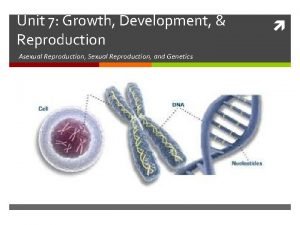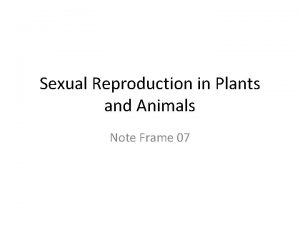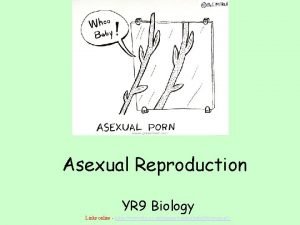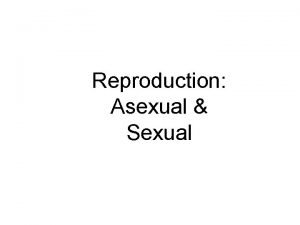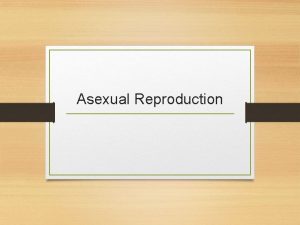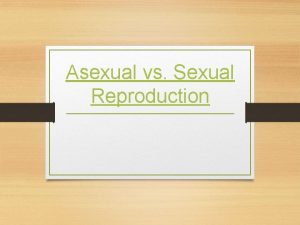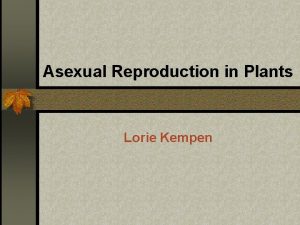Asexual Reproduction in Plants Asexual Reproduction in Plants













- Slides: 13

Asexual Reproduction in Plants

Asexual Reproduction in Plants �Asexual reproduction is the formation of new individuals from the cell(s) of a single parent �It is very common in plants; less so in animals

Asexual Reproduction in Plants Important points about asexual reproduction in plant � Asexual reproduction in seed plants is common � Asexual plant reproduction requires only one organism � The new plants have the same genetic structure as the parents � Seed plants use different methods of asexual reproduction � Asexual reproduction is not as complex and requires far less energy � Organisms that are genetically identical to their parent are known as clones

Types of Asexual Reproduction �Rhizomes �Tubers �Runners �Cuttings �Bulbs �Corms �Cell Culture �Tissue Culture

Rhizomes � Plants such as the grasses, cattails and sedges produce underground stems or rhizomes � Buds produced at the nodes develop into branches that stay underground or develop into aerial shoots � If the rhizomes subsequently dies, a new separate plant will have been formed

Tubers �Tubers are actually modified rhizomes �They develop when specialized stem branches grow down into the ground and swell up with starch containing cells �Buds of the tubers will grow into new plants

Runners �These are horizontally growing stems that produce few, if any, leaves �The stems, called runners, creep along the ground �The runners can be cut from the parent plant and new plants will grow

Cuttings �Cuttings involve vegetative plants that have been removed and rooted in soil or other suitable material �Cuttings are made from stems, roots or leaves �A cutting or piece of carrot root can develop into a new carrot if placed over a container of water

Bulbs �Onions, chives and lillies winter in the form of a bulb �Each bulb has a very short stem which is surrounded by fleshy leaves �In the spring, the shoot apex begins to grow using the nutrients stored in the leaves

Corms �This structure is similar to bulbs except that there are no storage leaves �The nutrients are, instead, stored in the swollen stem

Cell Culture � Sometimes just one cell can regenerate into an entire plant � One cell from a carrot taproot is put into a tube of water with plant nutrients, the one cell divides and forms a bunch of cells under special conditions, roots and leaves develop, the small carrot plant grows into a carrot identical to the carrot from which the one cell came

Tissue Culture � Engineered cells of some plants can readily be used to regenerate entire plants under sterile conditions � Tissue culture works when the cell culture returns to an undifferentiated state � The process involves placing the engineered cells in an environment with special hormones and nutrients that encourage cell growth � Eventually the tissue culture forms leaves and roots and finally an entire plant

That's All I got for Today!!!!
 Sexual reproduction vs asexual reproduction venn diagram
Sexual reproduction vs asexual reproduction venn diagram Hare lynx
Hare lynx Asexual reproduction vs sexual reproduction venn diagram
Asexual reproduction vs sexual reproduction venn diagram Chapter 19 asexual reproduction answer key
Chapter 19 asexual reproduction answer key Why is asexual reproduction beneficial
Why is asexual reproduction beneficial Complete the sentences to summarize the article
Complete the sentences to summarize the article Where does cactus store water
Where does cactus store water Asexual amphibians
Asexual amphibians Sexual or asexual reproduction
Sexual or asexual reproduction Runner plant examples
Runner plant examples Types of asexual reproduction and examples
Types of asexual reproduction and examples Advantages of genetic diversity
Advantages of genetic diversity Examples of asexual reproduction
Examples of asexual reproduction Asexual or sexual reproduction
Asexual or sexual reproduction





